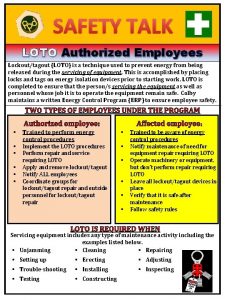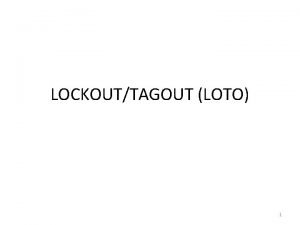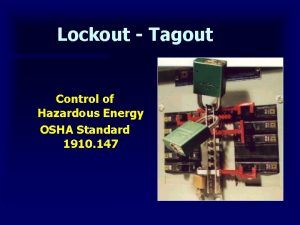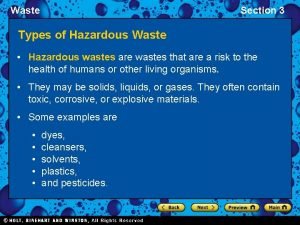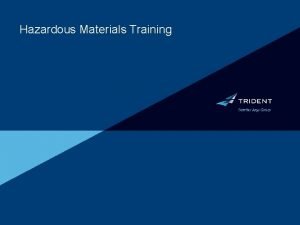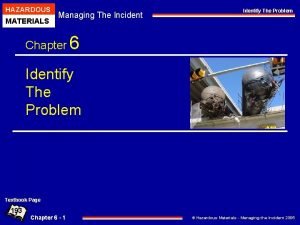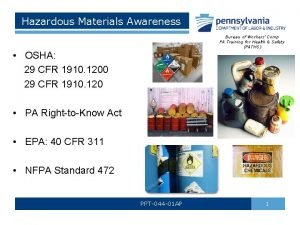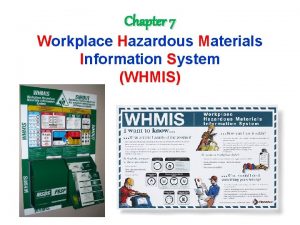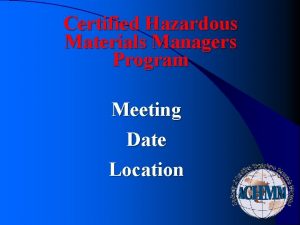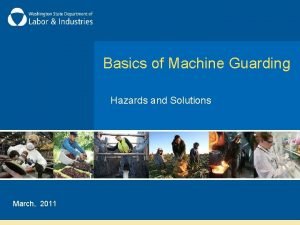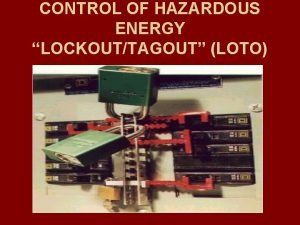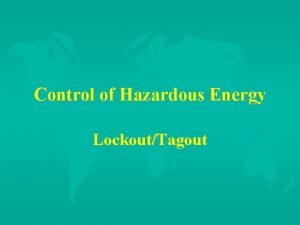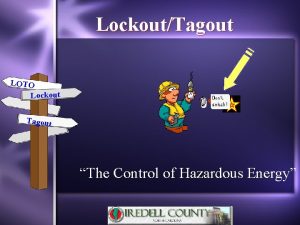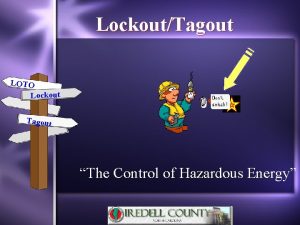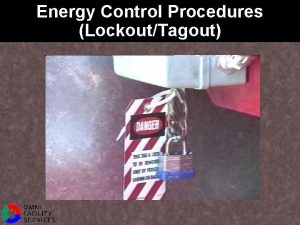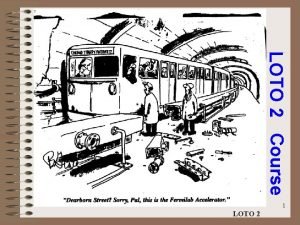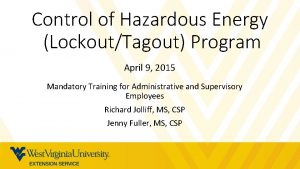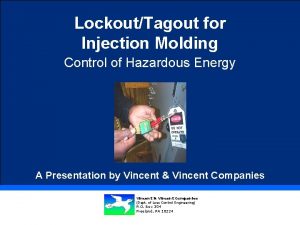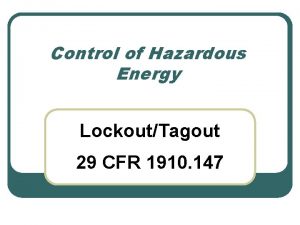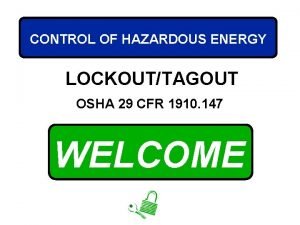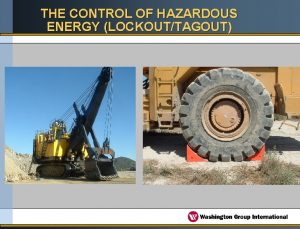LockoutTagout LOTO Control of Hazardous Energy March 2021






















- Slides: 22

Lockout/Tagout (LOTO) Control of Hazardous Energy March, 2021 All photos from Adobe Stock unless otherwise indicated

What will be covered What is hazardous energy? How is hazardous energy controlled? What is lockout/tagout? Lockout/tagout procedures Specific tagout requirements Group lockout/tagout 2

What is hazardous energy? Mechanical – machinery moving parts Electrical – live or stored electrical energy Hydraulic – compressed or moving liquids Pneumatic – compressed air or gas Gravitational – raised objects that can fall Thermal – extremely hot liquids or cold gas Radiation – lasers, microwave, ultraviolet, x-rays All of these energy sources can either be stored or be active. 3

Stored energy Can include the following: Fluids or gases still in the equipment and under pressure, electrical stored energy in batteries or capacitors, parts of machinery that are affected by springs or gravity or could otherwise move. 4

How to control hazardous energy Identify all energy sources – potential (stored) or kinetic (moving or existing). De-energize equipment by isolating or blocking the energy source. Dissipate or release stored energy. Lock out the equipment’s energy source, so it cannot be reactivated by anyone while equipment is being serviced. 5

What is lockout/tagout? "Lockout/Tagout (LOTO)" is specific practices and procedures to safeguard employees from the unexpected energization or startup of machinery and equipment, or the release of hazardous energy during service or maintenance activities. 6

Why lockout/tagout is needed You. Tube video – Lockout/Tagout You. Tube Video - LOTO is not a choice - It would have saved his life 7

An example of a hay bale cutter LOTO fatality L&I photos A worker died when he crawled into this hay bale cutting machine to dislodge a hay bale without locking it out first. His weight activated the guillotine cutting blade which struck him. 8

When are lockout/tagout procedures needed? When employees do service or maintenance on or around any equipment that has hazardous energy, When equipment or machinery is being installed or removed, When a guard or other safety device is bypassed or removed. 9

When is lockout not required? Service and maintenance during normal production operations: if an employee is not required to remove or bypass a guard or other safety device; or place any body part into the point of operation or any other hazardous area created by machine operation. Minor tool changes, adjustments, and other minor service during normal production: If they are routine, repetitive, and integral to the use of the equipment for production; and the work is done using measures which provide effective protection from hazards. 10

What is a lockout device? It is a device that positively holds energy isolating devices or measures in a safe position to prevent the reenergizing of equipment. It can be a key or combination lock, or blank flanges in piping. It includes a tag or other notice that identifies the person authorized to remove the lock. 11

Authorized and affected employees An “authorized employee” is a person who has been properly trained to lockout/tagout procedures on machinery or equipment that is to be serviced. L & I photos An “affected employee” is a person who operates the machinery or equipment, but does not perform the lockout procedures, or a person who works in the area where machine or equipment maintenance is being done. 12

Six steps of lockout/tagout procedures 1. Preparation – get ready, inform all affected employees 2. Shutdown – turn off or shut down operating equipment 3. Isolation – install isolating devices or implement procedures to block hazardous energy 4. Lockout/Tagout – apply LOTO devices or procedures 5. Stored energy check – verify that stored energy is released or restrained 6. Isolation verification – test to make sure LOTO is working 13

Once locked out – no unauthorized restart! 14

Starting up equipment again Remove all tools, replace guards, and make sure the equipment is ready to re-energize. Notify all affected employees and make sure they are clear of area. The authorized person removes the lockout/tagout device. Start-up or reactivate equipment. 15

Using tagout devices only Tags are warning devices and do not provide the same level of physical restraint as a lock. Tags may give a false sense of security. Tags can’t be removed without the approval of the person responsible for it. Tags cannot be bypassed, ignored or otherwise defeated. 16

More tagout rules Tags must be legible and understandable Tags must be made of materials that will withstand the environmental conditions they are exposed to. Tags must be securely attached to energyisolating devices so they can’t be accidently removed. 17

Group lockout/tagout A primary authorized employee must be assigned who has overall responsibility. Each authorized person puts a lockout/tagout device on equipment. No lockout/tagout device can be removed until the work is done. The primary is the last person to remove their lockout/tagout device. 18

LOTO is required on the following equipment List machinery or equipment here 19

Our lockout/tagout procedures Describe your procedures here Link to Sample Lockout Procedure Template 20

Our lockout/tagout program Describe your program here or pass out copies of written program Link to Lockout/tagout Rule 21

Further training for authorized employees Provide training on specific lockout/tagout procedures on specific machinery or equipment for authorized employees 22
 Anthem of poland
Anthem of poland Lock out tag out safety talk
Lock out tag out safety talk Loto
Loto Loto kombinacije program
Loto kombinacije program Loto u
Loto u Tagout
Tagout Weekly quiz answers 2021
Weekly quiz answers 2021 March 5 2021
March 5 2021 Energy energy transfer and general energy analysis
Energy energy transfer and general energy analysis Energy energy transfer and general energy analysis
Energy energy transfer and general energy analysis Section 3 hazardous waste answers
Section 3 hazardous waste answers Aviation hazardous attitudes
Aviation hazardous attitudes Biomedical waste management introduction
Biomedical waste management introduction What is hazardous material
What is hazardous material Hazardous materials table
Hazardous materials table Us military marking system for hazardous materials
Us military marking system for hazardous materials Pa-psfa-hazardous materials awareness
Pa-psfa-hazardous materials awareness Avhf
Avhf Avhf
Avhf Shape and color of whmis 2015 symbols
Shape and color of whmis 2015 symbols Chmm accreditation training
Chmm accreditation training In running nip points
In running nip points Hazardous waste apes
Hazardous waste apes

